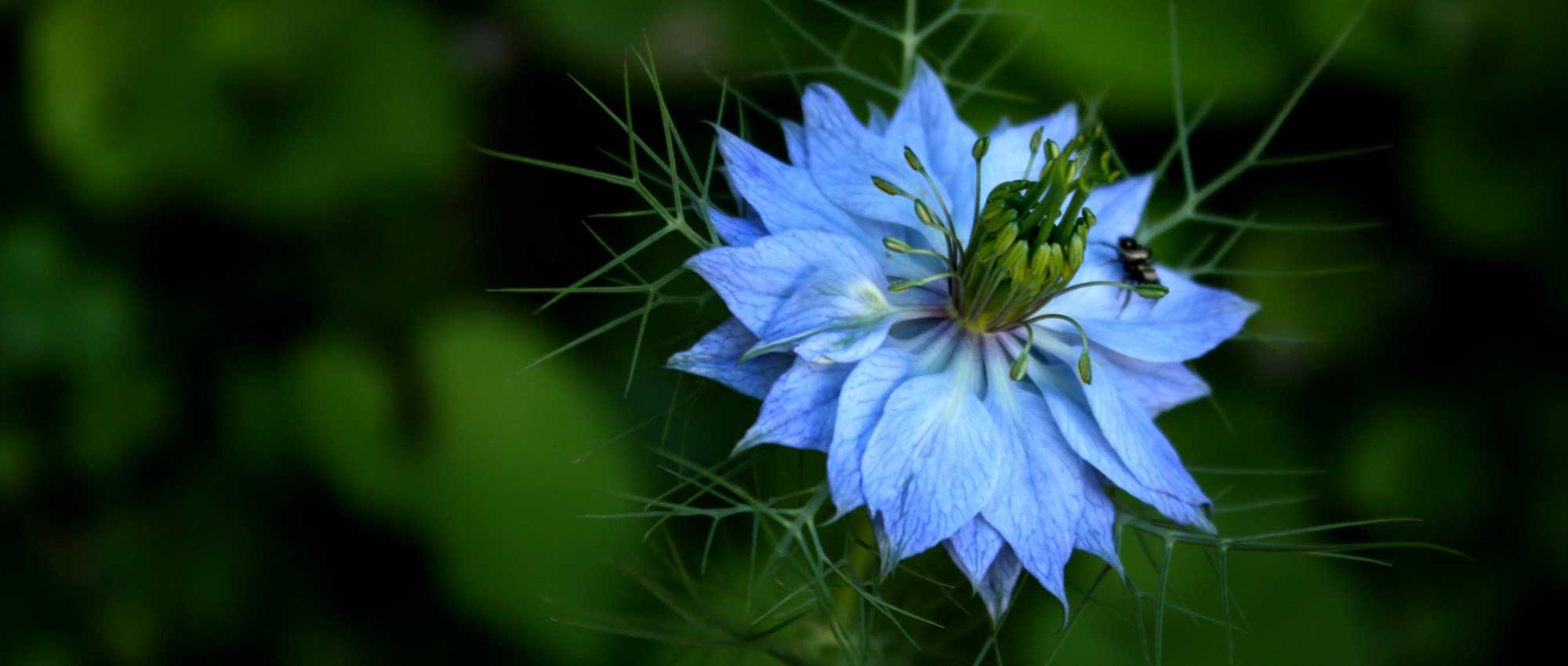
Damask Nigella: sowing, cultivation and care
Contents
Nigella damascena in a nutshell
- Love-in-a-mist offers a beautiful starry flowering, often blue, but also white or pink
- Its very fine, airy, and light foliage is appreciated
- It bears extremely decorative fruits!
- Love-in-a-mist is a small plant with a very natural appearance… It has a lot of charm!
- Very easy to sow and to grow, it thrives almost anywhere and requires hardly any maintenance!
- It self-seeds spontaneously in the garden
A word from our Expert
Nigella is a small annual plant that offers an airy, refined flowering and extremely fine decorative foliage! The most well-known is the Damas nigella, Nigella damascena. It bears star-shaped flowers, often blue, but they can also be pink or white. You can pick its flowers to create cut flower arrangements… and even design dried bouquets with the fruits, which are almost as decorative as the flowers! Nigella is also known for its edible seeds; however, this refers to a different species, Nigella sativa, not the ornamental one, Nigella damascena, so be careful not to confuse them!
Low-maintenance and requiring almost no care, nigella is among the easiest plants to grow! It thrives in well-drained, light soil, even if poor in organic matter. It enjoys being placed in full sun or light shade. It is not prone to diseases, and it is very simple to multiply by sowing! It also tends to self-seed spontaneously in the garden. It does not smother other plants but fills in the gaps in flower beds!
Botany
Botanical data
- Latin name Nigella damascena
- Family Ranunculaceae
- Common name Love-in-a-mist
- Flowering often between June and August
- Height between 20 and 50 cm
- Exposure full sun or light shade
- Soil type well-drained, light. It tolerates poor and rocky soils.
- Hardiness between -15 and -20 °C
The nigellas comprise around twenty species of annual plants native to Europe, Asia, and North Africa. The most well-known is the Love-in-a-mist, Nigella damascena. It can be found around the Mediterranean, in southern Europe, and North Africa. It grows wild in France, alongside a few other species of nigella. You can encounter it in fields, fallow land, along roadsides, and in rocky areas.
The name nigella comes from the Latin niger: black, referring to the colour of its seeds. In French, it is sometimes called Cheveux de Vénus (Venus’s Hair), due to the fineness of its feathery foliage, divided into linear segments. In English, nigella is known as Love in a mist (referring to the misty foliage) or Devil in the bush.
The nigella belongs to the family of buttercups, the Ranunculaceae. This is a large family, comprising over 2,000 species of predominantly herbaceous plants, often toxic. Hellebores, aconites, columbines, clematis, delphiniums, and anemones belong to this family.
The Love-in-a-mist is a small plant: it measures between 20 cm and 50 cm in height, sometimes reaching up to 60 cm, with a width of 20 to 25 cm. It grows taller when cultivated in a substrate rich in organic matter. It is best positioned at the front of borders, in front of taller plants. It forms clumps that expand over the years, composed of upright stems, sometimes branched, but can also be simple.
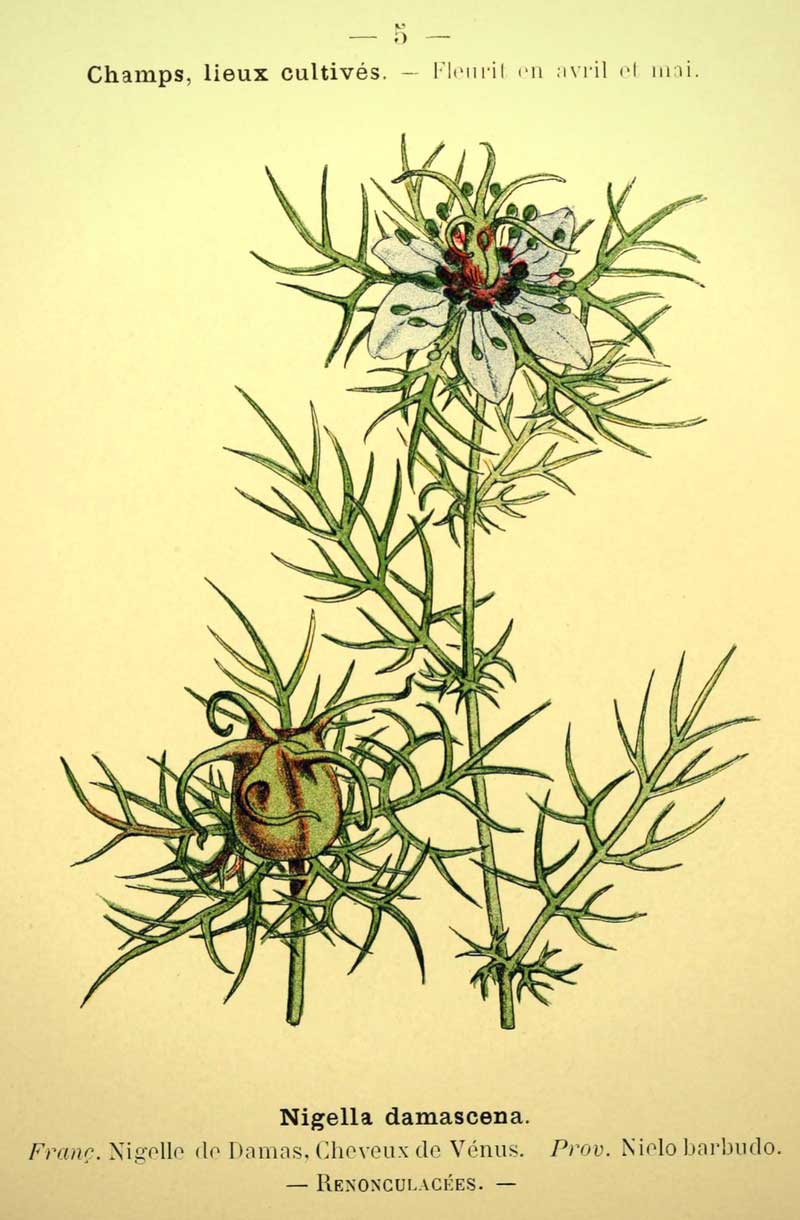
Nigella damascena: botanical plate
The nigella flowers in summer, typically between June and August, sometimes until September. The flowering can be earlier or later depending on when you sowed the seeds. It does not last very long… but is quickly followed by decorative fruits!
The nigella bears flowers in rather soft, pastel shades. They are often light blue, but can also be white or pink, sometimes almost red, or mauve-purple. Thus, the varieties ‘Persian Rose’ and ‘Mulberry Rose’ feature stunning pink flowers. The eastern nigella, Nigella orientalis, stands out with its yellow flowers! There are also seed mixes that produce an assortment of flowers in various colours. It is common for nigellas to display beautiful nuances, with their shades varying from one flower to another. Similarly, it often happens that the shade of a single flower changes slightly over time. For instance, the flowers of the ‘Mulberry Rose’ variety are initially soft pink when they bloom, becoming a more pronounced pink later. In the case of the ‘Dwarf Moody Blue’ variety, they are violet-mauve, evolving into a blue hue. Sometimes, the flowers offer a stunning contrast between the sepals, often white or light blue, and the pistils/stamens, which can be very dark, black, or burgundy.
The nigella has very beautiful star-shaped flowers, usually solitary and borne at the tips of the stems. They measure between three and five centimetres in diameter. They are composed of five to twenty-five petaloid sepals (which resemble petals), coloured. These surround five to ten petals, often smaller, which sometimes contain nectar consumed by insects. Nigella flowers are hermaphroditic: each has male (stamens) and female (pistils) organs. Thus, at the centre of the flower, there are five to ten pistils gathered and upright, surrounded by a large number of stamens. The styles, long and thin, resembling the segments of the leaves, are often curved towards the stamens to facilitate fertilization. The pistils and stamens are generally very decorative, adding more detail and refinement to the flower, and they sometimes provide a beautiful contrast with the lighter sepals. Directly beneath the coloured sepals, the nigella bears five bracts divided into fine strips, resembling the rest of the plant’s leaves. They are all inserted at the same level. The flower appears nestled in a silky bed of very fine leaves. Some nigellas stand out with very different flowering, such as Nigella ‘Blue Stars’, which has small five-petalled blue-violet flowers, with numerous stamens at the centre. They have a much simpler appearance than other nigellas!
Feel free to use nigella flowers to create bouquets! They hold up quite well in a vase.

A nigella flower bud opening (photo JLPC) / a flower of Love-in-a-mist / detail of the stamens and pistils
The leaves of the nigella are divided into extremely fine segments. They are laciniate, making them very decorative. They have a misty, light, feathery appearance. Their fineness gives the plant its name Cheveux de Vénus. The leaves of nigellas are alternate, placed one after the other on the stem. They measure between 8 and 15 centimetres in length and are light green in colour. The foliage of the nigella is quite characteristic, allowing for easy identification of the plant, even when it is still in the seedling stage.
The fruits of the Love-in-a-mist are very decorative. They are large, globular capsules, swollen, and turn brown at maturity. They are surrounded by fine, dried bracts all around, and they also bear thread-like, upright styles at their tops. The capsules are divided into different chambers that contain the seeds. They open when mature, releasing numerous small black seeds. These have three faces and are wrinkled, bearing striations. Although it is an annual, the nigella self-seeds, allowing it to persist in the garden. You can cut the stems bearing the capsules and incorporate them into dried bouquets. They are very decorative and original! However, do leave some fruits in place to allow the nigella to self-seed!
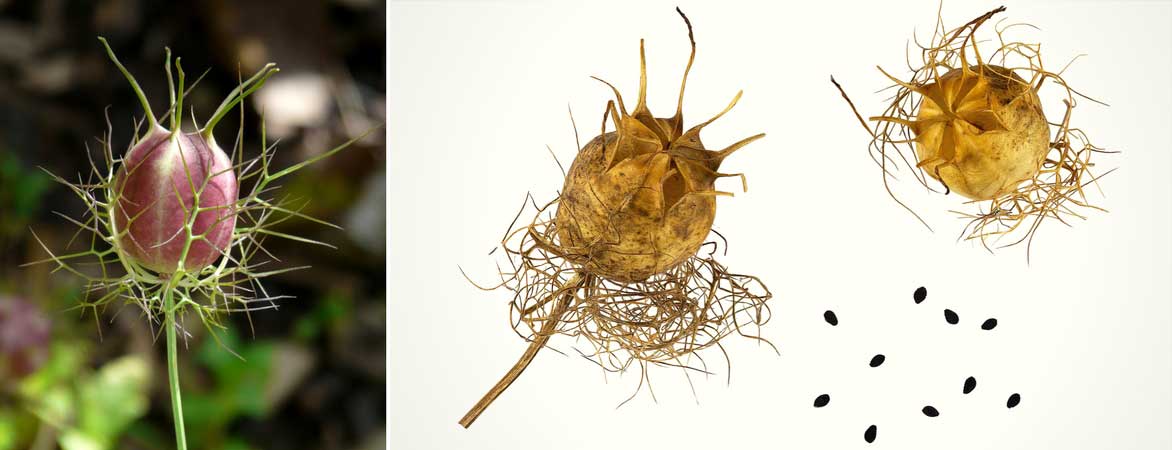
A capsule of Nigella / The fruits and seeds of Nigella damascena (photo Roger Culos – Museum de Toulouse)
Botanical species
- Nigella damascena
This is the true Love-in-a-mist, the most commonly cultivated for its ornamental value. It has given rise to many varieties!
- Nigella orientalis
The Eastern nigella bears yellow flowers, with petals curving downwards. It is appreciated for its original and bright flowering! The most commonly cultivated variety is ‘Transformer’.
- Nigella hispanica
It is taller than the Love-in-a-mist, reaching heights of 60-70 cm. It bears deep blue flowers and reddish stamens.
- Nigella sativa
This is the nigella cultivated for its seeds, which are used as a spice under the name Black Cumin. Its flowers are often light blue or white.
The main varieties of nigella

Love-in-a-mist African Bride Seeds - Nigella papillosa
- Flowering time July to September
- Height at maturity 50 cm

Love-in-a-mist Delft Blue Seeds - Nigella papillosa
- Flowering time July to October
- Height at maturity 60 cm

Love-in-a-mist Miss Jekyll Blue Seeds - Nigella damascena
- Flowering time July to September
- Height at maturity 50 cm

Love-in-a-mist Miss Jekyll Alba Seeds - Nigella damascena
- Flowering time July to September
- Height at maturity 50 cm

Love-in-a-mist Persian Rose Seeds - Nigella damascena
- Flowering time July to September
- Height at maturity 50 cm

Nigella damascena Moody Blues - seeds
- Flowering time July to September
- Height at maturity 50 cm

Nigella garidella Blue Stars - Love-in-a-mist Seeds
- Flowering time August to October
- Height at maturity 30 cm

Nigella Midnight Blue - seeds
- Flowering time June to October
- Height at maturity 70 cm
Discover other Nigella -Love-in-a-mist seeds
View all →Available in 1 sizes
Available in 1 sizes
Available in 1 sizes
Available in 1 sizes
Available in 1 sizes
Available in 1 sizes
Available in 1 sizes
Available in 1 sizes
Available in 1 sizes
Available in 1 sizes
Sowing
Where to Sow Nigella?
Sow nigella directly in open ground, in full sun or in a slightly shaded position. In too dense shade, its flowering may be less generous. Nigella prefers rich soils but can also thrive in poor soils. It is a relatively undemanding plant that can grow in any type of soil. It will be taller in nutrient-rich soils, but may develop more foliage at the expense of flowering. Nigellas prefer soils with a neutral pH.
Nigella appreciates well-draining substrates, where water easily infiltrates. It grows very well in sandy soils. If your garden soil is heavy, compact, and retains water, we recommend adding drainage materials: pumice, gravel, or coarse sand. Nigella is an easy plant that requires little: it is perfect for occupying areas of the garden where the soil is poor and dry, rocky. You can sow it on a bank or in difficult corners of the garden.
Nigella is a relatively low plant: place it preferably at the front of borders, just in front of taller plants. It can also help fill gaps in borders. Don’t hesitate to sow it alongside other annual plants (poppy, cosmos, etc.).
You can grow it in a pot or in a window box, which you can place on your balcony or on a windowsill.
→ Learn more in our tutorial: How to Sow Nigella Seeds?
When to Sow?
Nigella is often sown in spring, from March to May. However, it can also be sown in autumn, especially if you live in a region with relatively mild winters; in this case, it will flower earlier. The ideal is to stagger the sowings, so that the flowering occurs over a longer period!
How to Sow Nigella?
Sowing nigella is very easy! Preferably place it directly in its final location, as its roots are fragile and do not like to be disturbed.
In Open Ground:
- Prepare the soil by breaking up clumps and removing larger stones, roots, and weeds, to obtain a homogeneous surface of fine soil. Optionally, add some well-decomposed compost. Level the ground so that the sowing surface is flat.
- Sow by scattering the seeds on the surface of the soil. We recommend broadcasting for a fairly natural effect. You can also use a seed drill.
- Cover with a thin layer of potting soil, then lightly firm down.
- Water gently, in a fine spray.
Keep the soil moist until germination, which will occur in one to two weeks. Then, thin out the seedlings by removing some of the young plants. The remaining ones should be spaced about twenty centimetres apart.
In Pots:
If you wish to grow it off the ground, you can sow nigella in a pot or window box. Place a layer of drainage (gravel, broken pot pieces, or clay balls) at the bottom of the pot to allow for water drainage. Then, add a mixture of potting soil and coarse sand, scatter the seeds on the surface, and water in a fine spray.
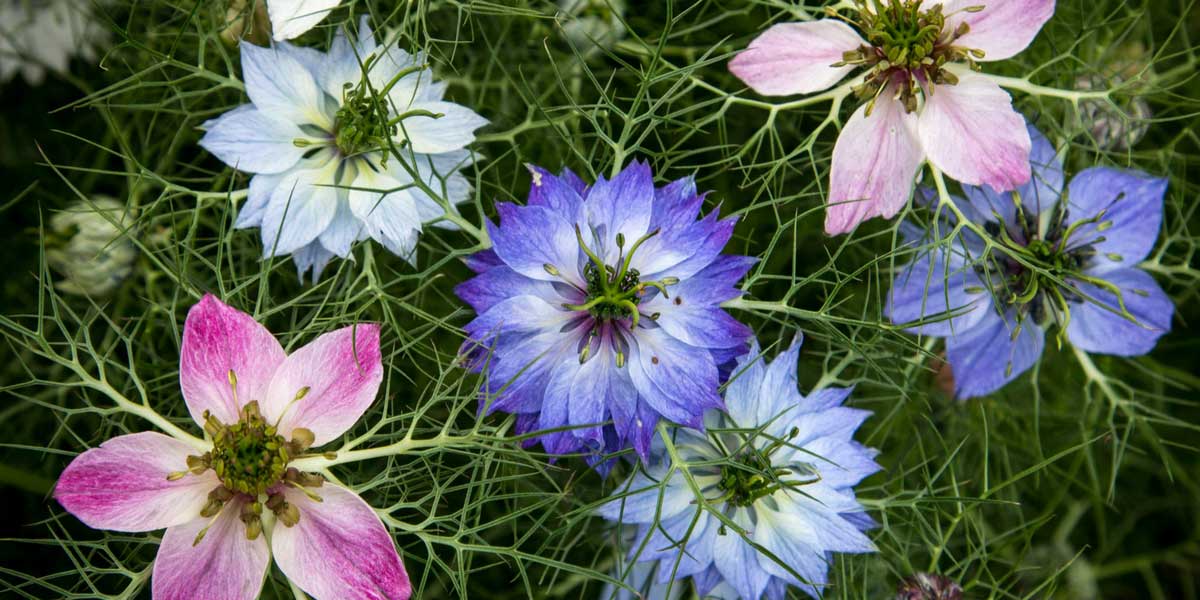
Read also
Sowing a flower meadow: why, howEntretien
Love-in-a-mist requires little maintenance, apart from occasional watering during hot weather and some weeding. Those grown in pots will need more frequent watering than those in the ground, as the substrate dries out more quickly.
We recommend leaving the faded flowers on the plant and not pruning them, to enjoy the decorative capsules that will form and allow the plant to produce seeds. You can either let it self-seed or collect the seeds for your own sowing or to give away! Although love-in-a-mist tends to self-seed, it is not invasive… It generally fills in gaps in borders.
You can weed the clumps of love-in-a-mist by removing the weeds that sometimes sneak in. Weeding is especially important when the capsules are present, to allow the seeds to settle on bare soil and self-seed easily. Conversely, it is easy to spot the young shoots of love-in-a-mist to remove them if they spread to an undesired location.
Feel free to harvest love-in-a-mist flowers for bouquets! Cutting them may slightly prolong the flowering; however, it will prevent you from enjoying the decorative capsules. Try to always leave a few flowers in place, both for self-seeding and to have some capsules. Moreover, these can also be used in dried bouquets! Cut the stems while they are still fresh, and tie them all together. Then hang them upside down to dry.
Love-in-a-mist is not susceptible to diseases. It requires no treatments! The only issue may come from slugs and snails, which sometimes eat the young shoots.
Multiplication
Nigellas multiply very easily by sowing, which you can do in open ground or in pots. When they are ripe, the capsules turn brown and begin to open slightly. This is the time to harvest them to collect the seeds! You can also allow the nigellas to self-seed, and possibly collect the spontaneous seedlings in the garden when they are still very young. Similarly, if you need to transplant the nigellas, do so when the seedlings are still small, as they do not tolerate being moved well.
It is possible to store the seeds for later sowing. Place them in a paper bag or an envelope, which you will keep in a dry, cool, and dark place. Remember to label them (plant name and harvest date). In theory, nigella seeds remain viable for two years, but it is preferable to sow them within the year.
Over the years, the flowers of horticultural varieties may slightly change colour. It may be worthwhile to purchase them again to return to the original variety.
Association
Love-in-a-Mist pairs perfectly with other annual plants to create a wildflower-style bed that looks very natural. For example, you can combine it with cosmos, especially those with white flowers (like the ‘Purity’ variety). Blue and white are colours that complement each other beautifully. It will also pair nicely with cornflowers (Centaurea cyanus), the intense red flowers of poppies, or the stunning blooms of Oriental poppies. Scatter these flowers among the fine foliage of grasses (Penisetum, Stipa pennata…), and enjoy the delicate spikes of Briza media. Plant Love-in-a-Mist alongside wildflowers, which have a lot of charm and lightness. In fact, Love-in-a-Mist is often found in wildflower meadow mixes! It can be combined with centauries, marigolds, sainfoin (Onobrychis viciifolia), wild chicory (Cichorium intybus), and especially with flax, Linum perenne. You’ll feel as if you’re in a true flower field!
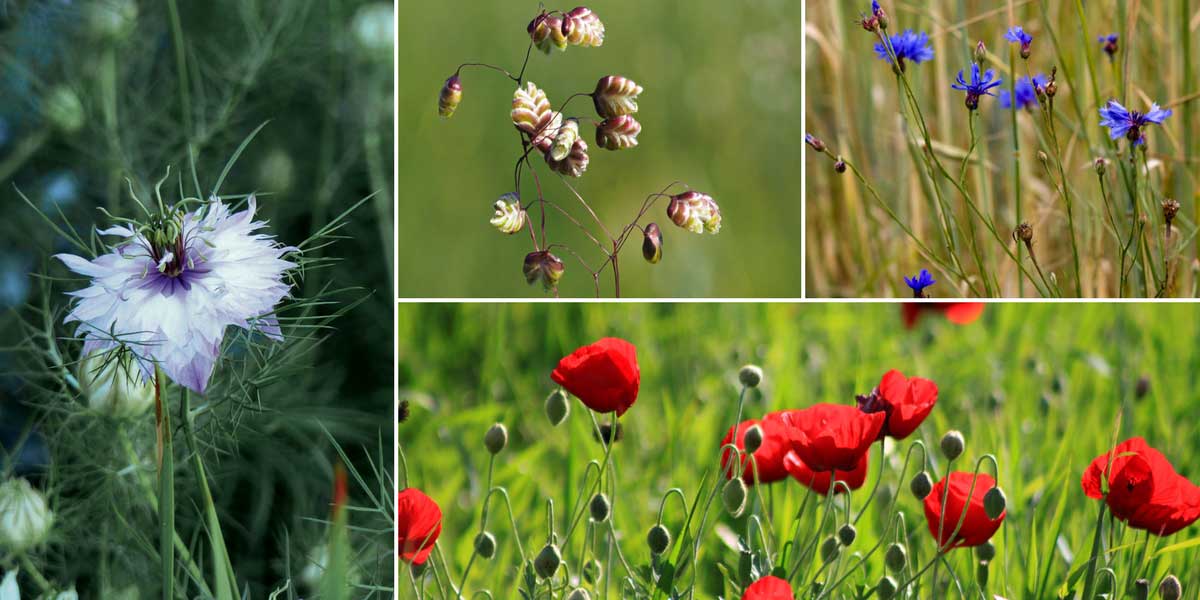
Love-in-a-Mist can be paired with the fine spikes of the grass Briza media (photo Hajotthu), as well as cornflowers (photo Tauri Pärna), and poppies
Love-in-a-Mist can also find its place at the front of a perennial bed. With the delicacy and refined nature of its flowers, it beautifully complements bush roses. You can position it right in front of them. Don’t hesitate to pair it with marigolds, California poppies (Eschscholzia californica), or Lychnis coronaria. It’s perfect for filling gaps in beds, spaces unoccupied by other plants! Their elegance and natural charm allow Love-in-a-Mist to pair beautifully with lilies (Lilium candidum, Lilium martagon, Asiatic lilies…). With this type of combination – Love-in-a-Mist, roses, lilies… – you can easily create stunning bouquets to decorate your home!
Take advantage of the different varieties of Love-in-a-Mist to play with colours! Those with white flowers will soften the brighter blooms of other plants. They have a very elegant appearance, and, when combined with roses, astrantias, and gypsophiles, you can easily achieve a very romantic garden! Plant blue-flowered Love-in-a-Mist with other blooms in similar tones: blue, mauve, and white. For an intense and deep bed, Love-in-a-Mist can be paired with plants in dark shades: purple, black, brown, midnight blue…
As Love-in-a-Mist tolerates poor, dry, stony soils well, you can plant it in a rockery, alongside other sun-loving and well-draining plants. For example, with grasses, yarrow, or lavenders…

An idea for a romantic bed: Rose ‘Darcey Bussell’ and Astilbe japonica ‘Peach Blossom’ (photo Nicola Stocken – GAP Photos) / Love-in-a-Mist ‘Mulberry Rose’ / Astrantia major ‘Ruby Star’
Did you know?
- A spice and a medicinal plant
The seeds of cultivated nigella, Nigella sativa, are often consumed as a spice, with a fragrance reminiscent of both strawberry and pepper. Already used in ancient Egypt, they are known as black cumin and are sometimes found in the spice blend raz-el-hanout. They can be sprinkled on salads or in dishes based on rice or vegetables… However, they should be consumed in moderation, in small quantities. Similarly, avoid consuming those from Damascus nigella; they are inedible and may even be toxic. Nigella oil is also produced, notable for its antioxidant and anti-inflammatory properties. It is used externally for skin or hair care, but also internally, where it can be added to salads or various dishes.
Useful resources
- Our Nigella seeds!
- Our advice sheet – Sowing annual seeds: how to do it successfully, in the ground or in trays
- An article by Ingrid on our blog – Natural garden, 5 remarkable wild plants
- To pair Nigella in the garden, you can draw inspiration from the Naturalist Garden atmosphere
- An interesting article on Nigella
Frequently asked questions
-
Can I sow love-in-a-mist in a pot to plant later in the garden?
It is possible, but rather discouraged, as the roots of the nigella are fragile and it does not tolerate transplantation well. If you must do it, intervene early: plant it in the garden when it is still at the seedling stage. It is always preferable to sow it directly in the ground.
-
Can I harvest and consume nigella seeds?
No, at least not those of the Damask nigella, Nigella damascena. The seeds used as a spice come from another species, Nigella sativa. Caution is advised, as nigellas belong to the family Ranunculaceae, which includes several toxic plants.
-
Can nigella become invasive if I let it self-seed?
No. Nigella self-seeds abundantly in the garden, but in a non-invasive way. It tends to fill gaps and unoccupied spaces. However, it is easy to weed out. If you want to stop its spread, simply cut the flowers or seed pods, and use them to create cut flower arrangements, for example... This will prevent it from self-seeding!
- Subscribe!
- Contents
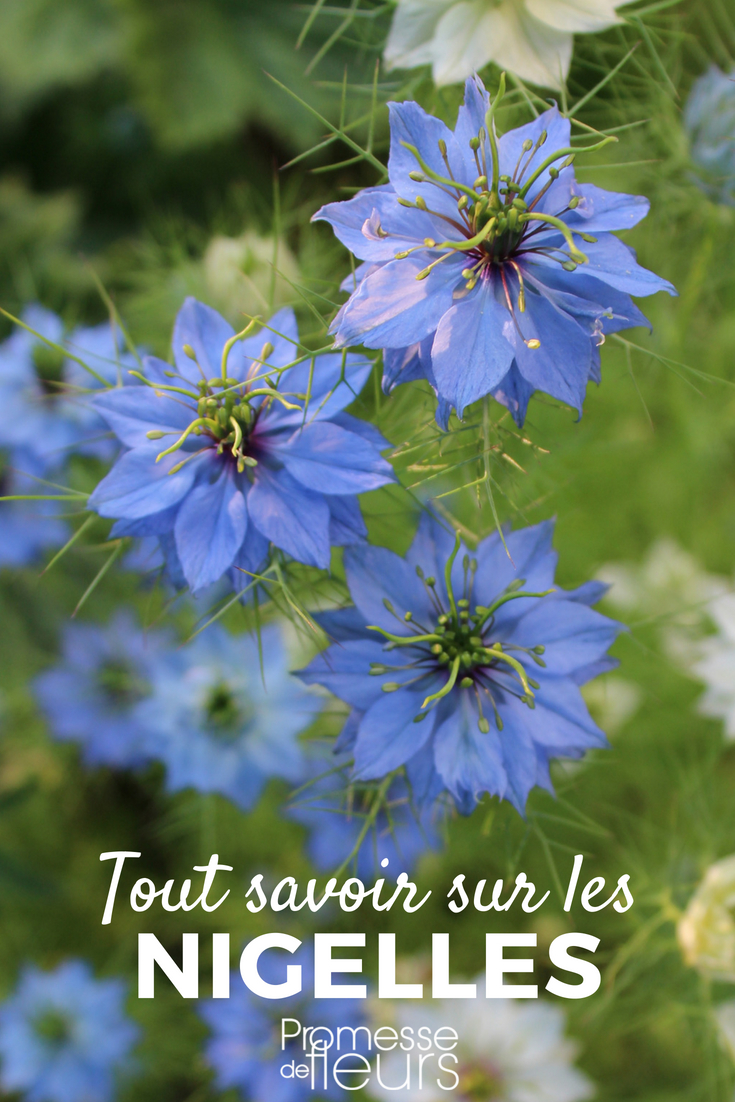































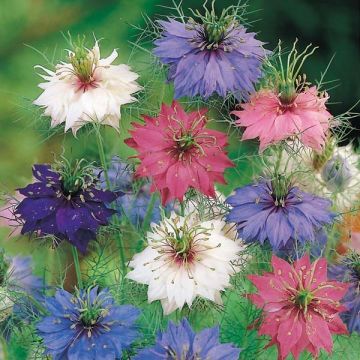
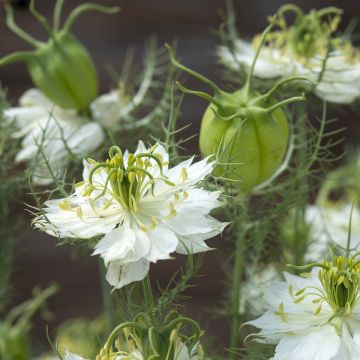
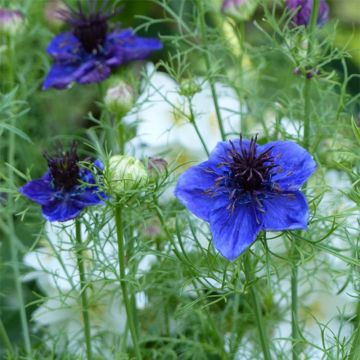
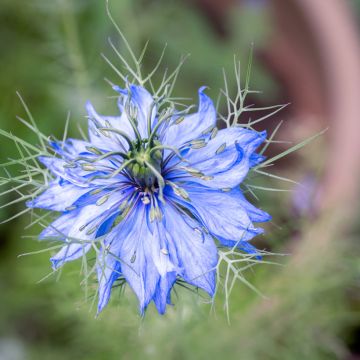



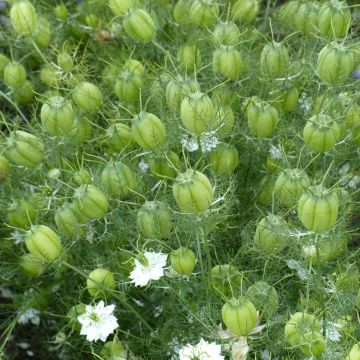
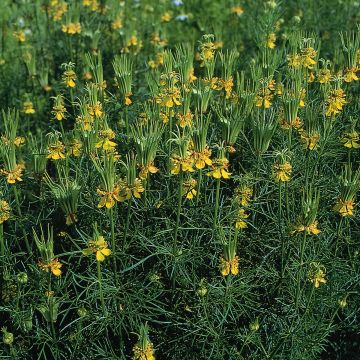

Comments